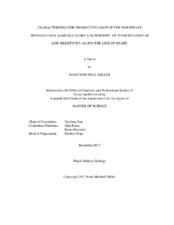CHARACTERIZING THE PRODUCTIVE LIMIT OF THE NORTHEAST PENNSYLVANIA MARCELLUS DRY GAS WINDOW: AN INVESTIGATION OF LOW RESISTIVITY ALONG THE LINE OF DEATH
Abstract
The Marcellus Shale is the single largest U.S. natural gas resource, both currently and for the foreseeable future. Whereas the Northeast Pennsylvania Marcellus Dry Gas Window produces a significant portion of total Marcellus production, it is burdened by a phenomenon known as the “Line of Death” (LOD), a coined term referring to an undefined line of demarcation that forms the southernmost limit of commercial production in the NE PA Dry Gas Window. The noncommercial wells to the south of the LOD have XRD values, TOC wt%, Ro%, and mineral composition comparable to commercial wells north of the LOD. However, for reasons not understood, noncommercial wells to the south of the LOD are characterized by very low resistivity values and lower total porosity values.
The hypothesis of this study is that the resistivity patterns and production trends observed in the NE PA Dry Gas Window suggest that some type of progressive, yet subtle, organic material (“OM”) transition at the nano-scale has occurred south of the LOD. This study characterizes portions of the NE PA Dry Gas Window on both sides of the LOD using 1) conventional electric logs and core analysis to prove bulk density similarity, 2) S/TEM, EDS and Raman Spectroscopy techniques to investigate the sources of conductivity in the OM, and 3) Large-scale, high-resolution SEM imaging and nitrogen adsorption to evaluate OM hosted pore size distributions and measure capacity to hold gas.
Regarding the low resistivity to the south of the LOD, the STEM and EDS discovered silver dispersed throughout the OM in both porous and non-porous samples
south of the LOD, while the OM Raman spectra provided evidence of increased carbon ordering (below graphite grade) south of the LOD. Regarding porosity, the large-scale SEM image segmentation and the nitrogen adsorption confirms that there is a quantifiable difference in the micro and meso pore size distributions between the north and south sides of the LOD, with samples south of LOD having significantly less pore area in the 1-2nm pore range. This study contends that the porosity deficiencies noted south of the LOD are linked to its increased carbon ordering.
Subject
Pore Size DistributionSEM
TEM
STEM
N2 Adsoprtion
Organic Matter
TOC
Macroporous
turbostratic
Marcellus
Line of Death
Dry Gas Window
Maturity
Citation
Miller, Noah Mitchell (2017). CHARACTERIZING THE PRODUCTIVE LIMIT OF THE NORTHEAST PENNSYLVANIA MARCELLUS DRY GAS WINDOW: AN INVESTIGATION OF LOW RESISTIVITY ALONG THE LINE OF DEATH. Master's thesis, Texas A & M University. Available electronically from https : / /hdl .handle .net /1969 .1 /169591.


